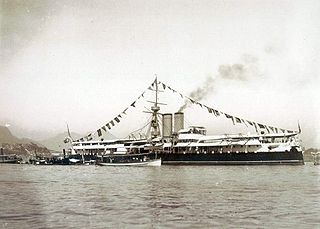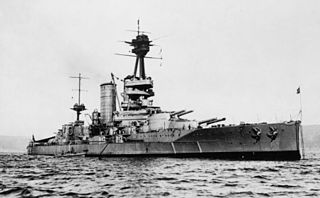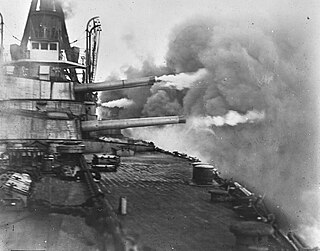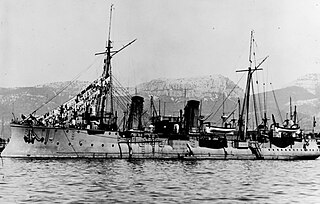The Brazilian Navy is the naval service branch of the Brazilian Armed Forces, responsible for conducting naval operations.

Bahia was the lead ship of a two-vessel class of cruisers built for Brazil by the British company Armstrong Whitworth. Crewmen mutinied in November 1910 aboard Bahia, Deodoro, Minas Geraes, and São Paulo, beginning the four-day Revolta da Chibata. Brazil's capital city of Rio de Janeiro was held hostage by the possibility of a naval bombardment, leading the government to give in to the rebel demands which included the abolition of flogging in the navy. During the First World War, Bahia and its sister ship Rio Grande do Sul were assigned to the Divisão Naval em Operações de Guerra, the Brazilian Navy's main contribution in that conflict. The squadron was based in Sierra Leone and Dakar and escorted convoys through an area believed to be heavily patrolled by U-boats.

The Bahia class was a pair of scout cruisers built for Brazil by Armstrong Whitworth in the United Kingdom, based on a design that borrowed heavily from the British Adventure-class scout cruisers. The class comprised the lead ship Bahia and her sister Rio Grande do Sul, along with a canceled third ship, Ceara. Both were named after states of Brazil. As a class, they were the fastest cruisers in the world when commissioned, and the first in the Brazilian Navy to use steam turbines for propulsion.

Riachuelo was a Brazilian ironclad battleship completed in 1883. She was named in honour of the Battle of Riachuelo in 1865. Built in the United Kingdom, the ship entered service with the Brazilian Navy in 1883 and remained in service until 1910.

Almirante Tamandaré was a protected cruiser operated by the Brazilian Navy from 1897 to 1915. The construction of the cruiser was the result of Brazil's effort to develop a large steel ship, but the country had no experience with this type of ship, and the project resulted in an unreliable vessel.

The Almirante Latorre class consisted of two super-dreadnought battleships designed by the British company Armstrong Whitworth for the Chilean Navy. They were intended to be Chile's entries to the South American dreadnought race, but both were purchased by the Royal Navy prior to completion for use in the First World War. Only one, Almirante Latorre (HMS Canada), was finished as a battleship; Almirante Cochrane (HMS Eagle), was converted to an aircraft carrier. Under their Chilean names, they honored Admirals (Almirantes) Juan José Latorre and Thomas Cochrane; they took their British names from what was then a dominion of Canada and a traditional ship name in the Royal Navy.

Two Minas Geraes-class battleships were built for the Brazilian Navy in the early twentieth century. Named Minas Geraes and São Paulo, these "dreadnought" warships were intended to be Brazil's first step towards becoming an international power, and they consequently initiated a South American naval arms race.

A naval arms race among Argentina, Brazil, and Chile—the wealthiest and most powerful countries in South America—began in the early twentieth century when the Brazilian government ordered three dreadnoughts, formidable battleships whose capabilities far outstripped older vessels in the world's navies.

The Arsenal de Marinha do Rio de Janeiro (AMRJ) is a military organization of the Brazilian Navy. It is located in Ilha das Cobras, at the Guanabara Bay, in the city of Rio de Janeiro. The Arsenal is the main maintenance center and naval base of the Brazilian Navy, involving the design, construction and maintenance of ships and submarines, not only for the Brazilian Navy, but also friendly nations.

Rio Grande do Sul was a Bahia-class cruiser built for the Brazilian Navy in 1909–10.

In the late nineteenth and early twentieth centuries, the South American nations of Argentina and Chile engaged in an expensive naval arms race to ensure the other would not gain supremacy in the Southern Cone.

HMS Porpoise was an Acasta-class destroyer of the Royal Navy, which was built by Thornycroft between 1912 and 1914. Porpoise served through the First World War, taking part at the Battle of Jutland in 1916, where she was damaged. In 1920, she was sold to the Brazilian Navy serving under the name Alexandrino de Alencar and was renamed Maranhão in 1927. Maranhão remained in service when Brazil entered the Second World War, being used for patrol and convoy duties. She was disposed of in 1945.

Saetta was a Folgore-class torpedo cruiser built for the Italian Regia Marina in the 1880s. Armed with three 14 in (356 mm) torpedo tubes and six light guns, she was capable of a top speed of 17 knots. She was built in the mid-1880s, was launched in May 1887, and was completed in February 1888. Saetta spent the first decade of her career serving in the main Italian fleet, where she conducted peacetime training exercises. In 1897, she was withdrawn from front-line service and employed as a gunnery training ship, a role she filled for another decade. The Regia Marina ultimately sold Saetta for scrap in May 1908.

The Troude class was a group of three protected cruisers built for the French Navy in the late 1880s and early 1890s. The class, which was very similar to the preceding Forbin class, comprised Troude, Cosmao and Lalande. They were ordered as part of a fleet program that accorded with the theories of the Jeune École, which proposed a fleet based on cruisers and torpedo boats to defend France. The Troude-class cruisers were intended to serve as flotilla leaders for the torpedo boats, and they were armed with a main battery of four 138 mm (5.4 in) guns.

D'Iberville was the lead ship of the D'Iberville class of torpedo cruisers built for the French Navy in the 1890s. The class is also sometimes classified as torpedo gunboats or torpedo avisos. The D'Iberville-class ships were a development of earlier torpedo cruisers, with the chief improvement being a significantly higher speed. D'Iberville was armed with six 450 mm (17.7 in) torpedo tubes and a single 100 mm (3.9 in) gun as her primary offensive armament, though she had all of her torpedo tubes removed in 1896, just two years after entering service.

Casabianca was the third and final member of the D'Iberville class of torpedo cruisers built for the French Navy in the 1890s. The class is also sometimes classified as torpedo gunboats or torpedo avisos. The D'Iberville-class ships were a development of earlier torpedo cruisers, with the chief improvement being a significantly higher speed. Casabianca was armed with three 450 mm (17.7 in) torpedo tubes and a single 100 mm (3.9 in) gun as her primary offensive armament.

The D'Iberville class was a group of torpedo cruisers built for the French Navy in the 1890s. The class comprised three ships: D'Iberville, Cassini, and Casabianca.

Almirante Barroso was a protected cruiser operated by the Brazilian Navy between 1896 and 1931. It was the first Brazilian ship to have radio telegraphy. It represented Brazil in Argentina and Chile, in addition to other commissions. It was one of the government ships that faced the rebels in the Revolt of the Lash. It was decommissioned in 1931.

Tymbira was a torpedo cruiser operated by the Brazilian Navy, belonging to the Tupi-class along with Tamoio and Tupi. During the First World War it patrolled the Brazilian coast. It was dismissed from service on 30 November 1917.

Almirante Barroso was a cruiser operated by the Imperial Brazilian Navy and later the Brazilian Navy from 1882 to 1893. Its name is a tribute to Brazilian admiral Francisco Manuel Barroso da Silva, the Baron of Amazonas. Its construction began in 1880 at the Rio de Janeiro Navy Arsenal, being launched into the sea in 1882. The ship was a demonstration of the potential of the Brazilian naval industry at the time, built with a combination of wood and steel.



















